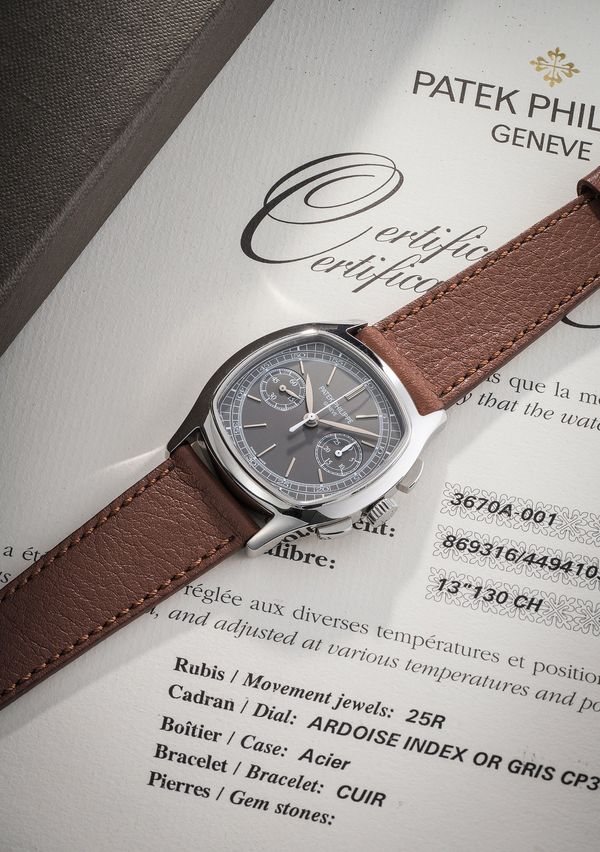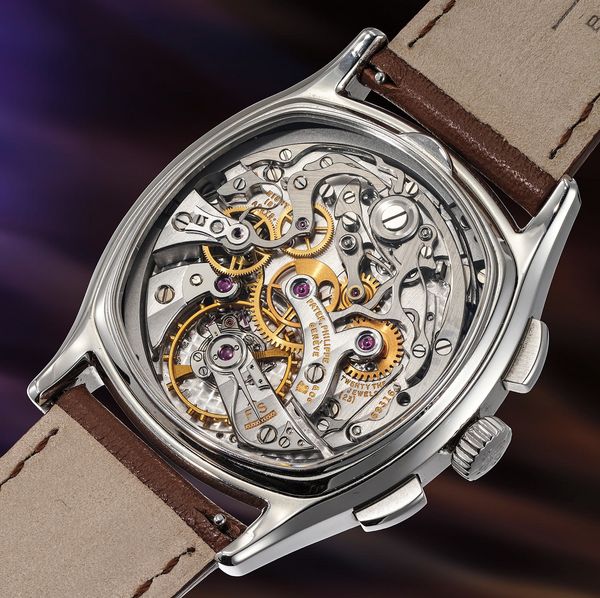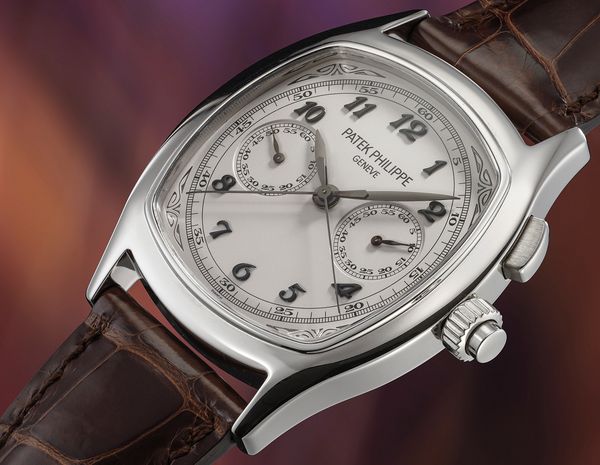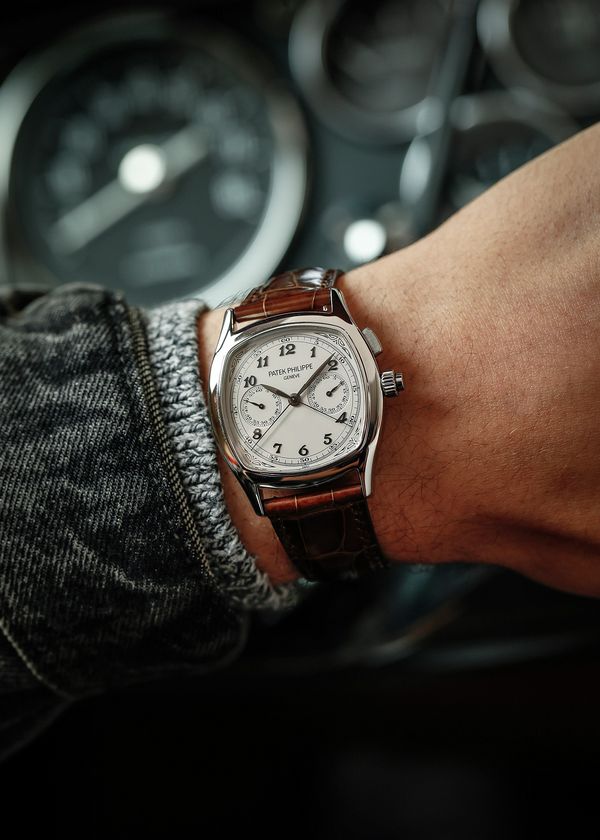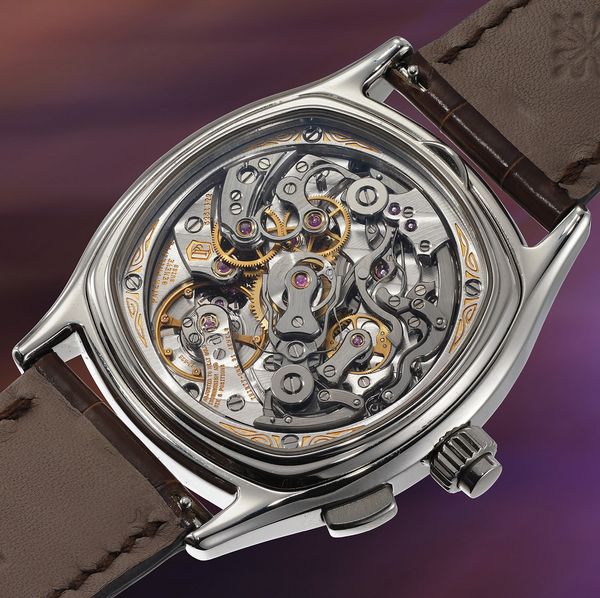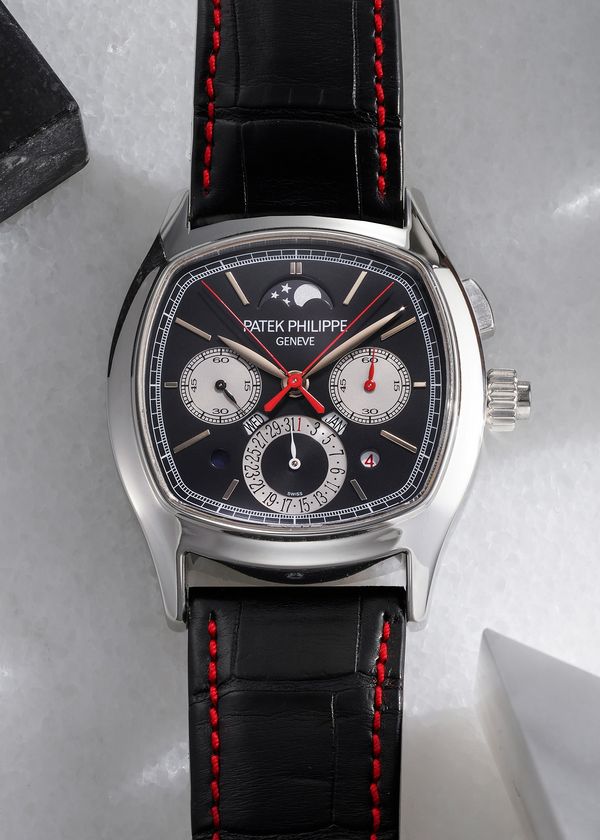Our first live auction of 2024, the PHILLIPS Geneva Watch Auction: XIX, takes place on May 11 and 12, at the Hotel President, at Quai Wilson 47 in central Geneva. The auction includes more than 215 of the world's finest watches – and though we are loath to boast, we truly think it's one of the best catalogs we've ever put together. We'll be highlighting a number of the most interesting lots and stories featured in the sale over the next month, including the Patek Philippe ref. 3670 and ref. 5950 featured in this article.
– By Logan Baker
The Patek Philippe Chronograph Ref. 3670
The Patek Philippe ref. 3670 is not only one of the rarest, elusive and desirable of all modern Patek Philippe wristwatches but the story behind its creation is filled with mystery and history.
In 1996, Patek Philippe prepared to move its workshops from the historic address of rue du Rhone to Plan les Ouates. According to the brand an old wooden chest was found on the 5th floor and in it were 16 vintage chronograph caliber 13-130 assembled and adjusted in 1955. Caliber 13-130 was a staple in Patek Philippe chronographs, found in the iconic ref 130 and 1463 to name just a few.
To celebrate this discovery, Patek Philippe disassembled and subsequently reassembled the 16 movements and housed them in stainless steel cushion cases inspired by the chronographs of the 1920s. To discover the unused movements was extremely remarkable. Yet, to case them in a stainless steel cushion case was, at the time, nothing sort of extraordinary. Apart from its split-seconds chronograph reference 5950 or the ultra elusive perpetual calendar split seconds chronograph reference 5004A, Patek Philippe hardly ever used stainless steel in the production of their high-end timepieces in modern times, saving them for charity or one-off events.
Producing a highly limited stainless steel chronograph wristwatch housing an original vintage movement was a bold and audacious move, sending collectors into an immediate frenzy. The watches were furthermore fitted with grey dials, giving it a modern and sporty appearance.
Launched in 2011, reference 3670 was an “application” watch. As such, only Patek Philippe’s most prestigious, deserving and loyal clients were granted the honor to own one such wristwatch. In fact, the present example is only the 3rd to ever grace an international auction market. Momentous in its aesthetic impact and gargantuan in its collectability, the present timepiece - is without a doubt one of the most important pieces from Patek Philippe’s modern history.
The Patek Philippe Split-Seconds Chronograph Ref. 5950
Patek Philippe’s split seconds chronograph production can be split (pun intended) into two divergent camps: those with a single button operating the chronograph mechanism through the crown and those with the traditional two-button layout. The first split seconds chronograph wristwatch produced by Patek Philippe came in 1923, with a Victorin Piguet-based ebauche housed in an 18K yellow gold officer-style case. Subsequent split seconds chronographs produced in series had two buttons: the reference 1436 (about 165 total examples produced between 1938 and 1971), the reference 1563, and the unique piece reference 2512. All of these references are highly coveted by collectors to this day.
Patek Philippe wouldn’t produce another split-seconds chronograph until 2005, with the launch of reference 5959. Ironically - and very much in Patek Philipe style - the all-new, in-house ultra-thin movement cal. CHR 27-525 PS sports a single-button architecture, harkening back to the very first split second chronographs made by the company. The caliber was an extraordinary achievement in fine watchmaking history as it was the thinnest split seconds chronograph ever created at the time, as well as being the thinnest column wheel chronograph. Its design brilliantly demonstrated the prowess and know-how of Patek Philippe in the field of complications.
This exquisitely finished movement incorporates a number of technical features (such as optimised teeth geometry and an improved clutching/unclutching system) that enable its remarkable thinness, and at the same time increase the energy efficiency and reliability of the chronograph complication. Furthermore, this was Patek Philippe’s first fully in-house designed and manufactured chronograph movement.
At Baselworld in 2010, Patek Philippe announced reference 5950, a cushion-style, single button split-seconds chronograph with the same in-house movement but boasting subtle Belle Epoque styling. The model is a treasure trove of surprises, the most obvious one being the fact that it is a highly complicated Patek Philippe model in steel. Complicated steel Patek somewhat betray the ethos of the company - a highly complicated evening watch shall be in precious metals, dictate the powers that be at Patek - and consequently are made in very scarce numbers both in present and past times. The result is that the category is considered “endgame” for Patek Philippe collectors.
Building on this foundation, we can find traits that seem designed to delight the connoisseur: from the applied black gold Breguet numerals to the black lacquer scroll detailing at the corners and on the buckle (and even in the corners of the additional solid caseback). The dial surface features an opaline/ivory finish obviously reminiscent of vintage watches, a feeling boosted by the railway fifth-of-a-second divisions and Arabic (in fact using a Breguet font, another subtle detail highlighting the meticulous design process behind the model) five-minutes divisions.
The current 5950A was brand new and freshly unsealed on January 26, 2024 for the purposes of shipping the timepiece. It comes complete with all of its original accessories and even the numbered factory plastic sleeve, still retaining sealed within the numbered sale tag - two items often discarded when delivering the watch. To date, it is the 15th example that has appeared on the market.
The Patek Philippe Split-Seconds Chronograph Perpetual Calendar Ref. 5951
Introduced in 2010, reference 5951 is one of the most intriguing modern creations of Patek Philippe. It was produced in three different series, starting with the present example, indeed a representative of the first series - defined by its black dial with red chronographic hands . A highly sporty design - not only due to the red hands, but also to the contrasting counters and chapter ring - it is very far from the usual super complicated Patek Philippe dress watch, while at the same time being one of the most advanced timepieces made by the brand. It in fact employs what was at the time the thinnest split seconds chronograph ever devised by the company (also used for sister reference 5950).
The caliber was then upgraded with a perpetual calendar module complete of moonphases, leap year and day/night indication; all this wealth of information very elegantly and subtly included in the lower part of the dial.
Following the first series, and probably in response to more than a few raised eyebrows, a second series featuring more conventional white and black dials with Breguet numerals was launched, and finally a last series with black dial and engraved case. With the retirement of the model, from 2017 there is no more cushion-shaped grand complication in the company's catalog.
You can learn more, place a bid, and view the entire Geneva Watch Auction: XIX catalog right here.
About Phillips In Association With Bacs & Russo
The team of specialists at PHILLIPS Watches is dedicated to an uncompromised approach to quality, transparency, and client service. Phillips in Association with Bacs & Russo holds the world record for the most successful watch auction, with its Geneva Watch Auction: XIV having realized $74.5 million in 2021. Over the course of 2021 and 2022, the company sold 100% of the watches offered, a first in the industry, resulting in the highest annual total in history across all the auction houses at $227 million.
About Logan Baker
Logan has spent the past decade reporting on every aspect of the watch business. He joined Phillips in Association with Bacs & Russo at the start of 2023 as the department's Senior Editorial Manager. He splits his time between New York and Geneva.
Recommended Reading
An In-Depth Collectors’ Guide To The Patek Philippe Chronograph Ref. 5070
Patek Philippe’s TV-Shaped Ref. 5020 Is A Genuine ‘90s Deep-Cut

